|
FAQs about Marine Snail
Identification 22
Related Articles: Gastropods, Sea Slugs, Mollusks, Abalone,
Related FAQs: Snail ID
1, Snail ID 2, Snail ID 3, Snail
ID 4, Snail ID 5, Snail ID 6, Snail
ID 7, Snail ID 8, Snail ID 9, Snail ID
10, Snail ID 11, Snail ID 12, Snail
ID 13, Snail ID 14, Snail ID 15, Snail ID
16, Snail ID 17, Snail ID 18, Snail ID
19, Snail ID 20, Snail ID 21, Snail
ID 23, Snail ID 24, Snail ID 25, Snail
ID 26, & Marine Snails 1,
Marine Snails 2, Marine Snails 3, Invertebrate ID, Snail Behavior, Snail Selection, Snail Compatibility, Snail Systems, Snail Feeding, Snail Disease, Snail Reproduction, Mollusks, Sea
Slugs, Abalone,
|
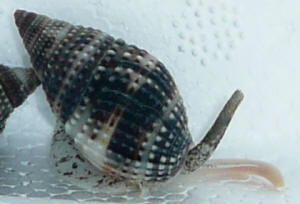
|
Unidentified life form; likely gastropod --
01/05/10
Crew;
<Hi John.>
Sorry to bother you again but I have found a new nocturnal inhabitant
in my tank a few hours ago and have looked on Google and you site and
other images but have no clue what it is. I attempted to get a picture
of it but since it was fairly dark (only moon lamps on and did not want
to scare the tank into awakening so early (3AM) I decided to leave well
enough alone and will describe it to the best of my ability. This is
the first time I have seen this little guy so I have no idea how long
it has actually been a member of my community.
Some brief history:
I found one of my larger Mexican turbo snails grazing near my Zoa
colony and after an hour or so later I noticed the Zoa was knocked off
the rock I had it tied to (obviously not very securely he he). So I did
an emergency re-tying down in the low light condition. When I pick up a
small piece of LR to get the other LR home of the Zoa retrieved and to
retrieve my fishing line I was using to tie down the Zoa I noticed
movement which started me a bit.
After a closer observation I thought what I saw was a snail but there
is not a visible shell. I watched it as it came across the substrate
and onto the glass. It measures 2cm in length (measured it while on the
aquarium glass), has two antennae (or what I deemed to be antennae) one
longer than the other. It had a foot very similar to a snail but again,
after looking closely through a 6x magnifying glass it had no
discernible shell. It was a pale color, almost gray in appearance with
a small hump in the back with what looked like spikes. I then assumed
it may be some type of slug, so I briefly turned on the lights (< 1
minute) to see if any color. The hump was a very very pale yellowish
color (almost white and the body had very small darker spots scattered
about all over except underside of foot). I turned the lights off again
and watched it for about 15 minutes. It went across the entire front of
the aquarium across the side then up near one of the powerheads when I
lost sight of it because it is not well lit there (remember have only
moon lighting on). I suppose it possibly could have been a hitchhiker
as well since the Zoa (was not attached to any rock/frag piece when
purchased) and Green Star Polyps (on a rock frag) (both very small) are
recent additions to the tank (Zoa about 3 weeks and the Star about a
week). I am hesitant to believe this came with the LR as a hitchhiker
due to the curing process and the newest piece of rock has now been in
tank only about 2 weeks now.
I have 2 Turbo Mexican Snails and 2 Nassarius snails in the tank.
Is it possible to have had this life form hitchhike on the LR, make it
through the full curing process and take up residence in my little
piece of the ocean?
<Oh yes. Many life forms are quite hardy and survive the processes
of transport and curing hidden in rock crevices.>
It was pretty quick for its size and I am almost certain it is a type
of snail just growing it's shell possibly?
<No.>
I thought all snails required a shell in which to retreat and live from
birth, either by growing or picking one up along the way.
<No picking up, they are no hermit crabs.>
Is it possible that one of the listed snails I mentioned had a
child?
<No.>
I apologize for asking you to try and ID something with just a
description and will send my picture I took if so requested to further
assist you.
<If you think it might help and contains at least some detail feel
free to send it.>
I do have a pic of it, but it is of the foot and another from an odd
angle to try and get the top portion of the life form but both are not
real
definitive so I do not want to ask you to identify something from a
picture, especially since it is of low quality. John. Marine tank
Newbie, Marine lover always.
<Without a clear picture it is hard to give you a definite ID. A
most common hitchhiker are Stomatella and related snails from the
family Haliotidae. They have small shells that may look like a bump and
long retractable antennae. They are fast for a snail and their flat
shell can have small holes. You may want to compare your hitchhiker to
some online pictures. Other less common hitchhikers are sea hares, they
have bumpy backs, no shell, ear like antennae (more often four). They
come in various colors and shapes. A third possibility is you saw a sea
slug (Nudibranch)'¦ there are more than 3000 species in
various colors and shapes. Cheers, Marco.>
Thanks for the assistance!!
Unidentified life form; likely gastropod II -- 1/6/10
Marco et al;
<Hi John.>
Just a follow-up on my recent question asking about my unidentified
hitchhiker.
Following your possible suggestions, I thoroughly researched each one
you mentioned. I easily ruled out Sea Hares. I looked at a lot of
images, some worse than what I took, lol). Took a few hours but I am
now pretty certain it is a Stomatella.
<Fine. I brought up the Nudibranchs, because you noted possible
spikes on the bump (which would be their breathing organs, but
Stomatella type snails can also have holes/tiny decorations on their
flat shell.>
This makes me a happy camper. I read they will reproduce. I have a few
questions related to them;
Will they consume red hair algae?
<Only if you have masses of Stomatella.>
I have read they are not compatible, necessarily, with wrasses. I have
2 McCosker's Flasher Wrasses. Is this a bad pairing?
<I cannot exclude they'll eat smaller individuals, but I think
this comment mostly applies to snail eating wrasses and/or small snail
species.>
If I have seen one, what are the odds there are more? (am interested in
hopefully reproducing more.)
<Quite good, they often lead a secretive life.>
I must add, you guys are amazing. Being able to at least steer one in
the correct direction, with just enough info, that if one truly does
their research can further their knowledge. You have done exactly that.
You gave a few possibilities, I researched and now am a tad bit more
knowledgeable. I appreciate this gentle guidance more than words can
say.
<Thank you very much for your kind words.>
For someone who is new to the hobby, I do try to use the search engine
as much as possible, but it can be a bit hard when one has no clue what
direction to search... hard to search for something when one has
absolutely no idea where or what they are searching for!
<Kudos to you for your effort. Not every hobbyist would be willing
to spend a few hours on a snail he saw once at night.>
Much appreciated. John. Marine tank Newbie, Marine lover always.
<Cheers, Marco.>
|
Re: Zoa placement and new id confirmation please --
12/15/09
G'Day to the crew!
<And you Richard>
The Zoanthids/Palys in contact with the feather duster is
(as you stated) no issue... may even provide a little added
protection for one or another - thank you to Bob for your input!
On a new front, snails. I have a couple
that have shown up, one in my isolation tank - one in my main,
and I am having difficulty discerning the difference betwixt the
Collonista,
<I think this is what this is>
the Heliacus or a Meriad or others that are 'close'. I
was unable to get a picture to show from your site of the
Collonista, and at least 3 from other web sources that were
conflicting. Mine measure aprox. 5 mill across, and
seldom travel the substrate or glass. Would you be so kind as to
help identify them please?
<The genus Collonista>
I appreciate the assistance... again,
Richard J.C.
<Welcome! BobF>
|
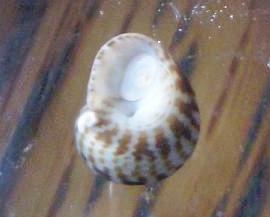 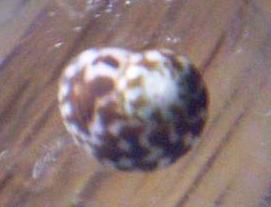 |
Re: question for the experts. Snail ID f' --
12/09/09
Thank you so much for the great info, and again thank you SO SO much
for your website. After reading through the mystery invert id pages, I
actually think the snails are Stomatellids. Anyway thanks again for the
amazing
service you provide, its really priceless.
<It is for you, your enjoyment and successes that we labour Katie.
Cheers, Bob Fenner>
|
What Are These? Egg Capsules -- 11/29/09
Greetings to you at WWM!
<Woo-hoo and greetings to you too, Jamie! Lynn here this
afternoon.>
I tried to find this "thing" on WWM and did not have
much luck. What are these?
<Egg capsules.>
I've just emptied my tank of fishes due to ich and today I
saw these on my glass! Scary!
<Nah, they're neat!>
I tried to look for them at other places in the tank but these
are the only ones that I can see. I imagine that I wouldn't
be able to see them if they were on anything else but glass. I
guess in a way that I'm lucky that they are where they're
at! They look like some type of eggs or crustaceans, I hope
it's not another parasite!
<Nope, they look like snail egg capsules to me. By any chance,
do you have any Columbellids, aka dove snails in residence?
They're small, harmless/beneficial grazers of film algae,
etc., in the family Columbellidae. Please see the following link
for photos and more information:
http://bb.wetwebmedia.com/viewtopic.php?f=25&t=341 . By the
way, mine come out of the proverbial woodwork at night to graze
on the glass, so if you don't see any during the day, be sure
to take another look after the lights go out. If you don't
have any of these snails, please let me know what kind (if any)
you do have, along with the size of the individual capsules, and
we'll see if we can't solve this mystery.>
Do I need to do something to the DT to treat for these
things?
<Nope, let's see if we can't first figure out what
left these on the glass. Worse case scenario, if they're from
a snail you don't want, you can scrape the capsules off and
suction them out. After that, it's a matter of locating and
removing the snails.>
It's a 225 gallon reef tank sans fishes.
<Nice size>
I've enclosed a photo.
<Nice photo!>
Thanks So Much!
<You're very welcome!>
Jamie Barclay
<Take care, Lynn Zurik>
|
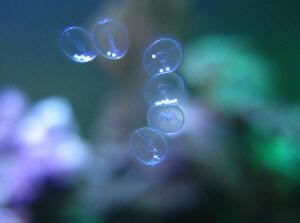 |
Re: What Are These? Egg Capsules --
11/29/09
<Hello, Jamie>
Yippi!
<Yay!>
I actually like these snails very much. They came FREE with my live
rocks!
<Love it when that happens!>
Thank you for sending the link to the pictures, I have one grazing
on the back wall as we speak.
<You're very welcome. Columbellids are terrific little
snails.>
I had sent another e-mail a day ago but had no response yet. I
thought WWM was "resting" over the weekend, but seeing
that YOU are here...I've copied it and pasted it here. I hope
you don't mind giving me your thoughts on this!
<I'd love to but I'm going to instead leave it in
Chris's far more capable hands!>
Thanks again Lynn!
<It was my pleasure!>
[?] I'm glad to see another woman who's into the hobby!
<We've got plenty of company!>
Jamie Barclay
<Take care, LynnZ> |
|
Snail hitchhiker 11/27/09
Could you guys/gals possibly tell me what this is and whether it
is reef safe or not?
<Mmm, looks to be a predatory Fasciolariid species. See
here:
http://wetwebmedia.com/MolluscPIX/Gastropods/Prosobranch%20PIX/Conchs%20Strombids/ConchF1.htm>
The only snails I have in the tank purposely are Astraea,
Margarita, Nerites, Cerith and Nassarius. I don't think this
is any of those. The size is about 0.5 cm at the moment.
Thanks much!
Roxanne
<I'd remove this animal. Bob Fenner>
|
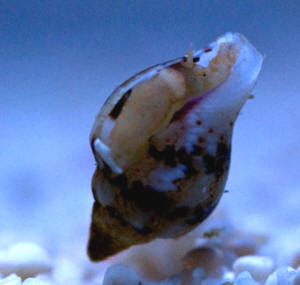 |
|
Slug ID, cutest Scutus 11/24/09
Hi Crew,
<Howdy Shanne!>
Just want to say you have an awesome site. Have spent many nights
glued to WWM.
<I'm mainly annealed in the AMs>
I was changing out my skimmer as I am currently battling a very
annoying algae problem (Diatoms) and didn't feel the one I
had was doing much to help. As I was pulling pieces out of my
sump, I came across this critter crawling across my floor.
It really moves, as it goes on its way 2 antenna wave back and
forth and as you can see it has a hairy back. Not sure if I want
this thing back in my tank or should I send him packing?
<Is fine... a type of Limpet. Please see here:
http://wetwebmedia.com/MolluscPIX/Gastropods/Prosobranch%20PIX/Limpets%20Scutus/LimpetF1.htm>
I have a 180G reef tank with a 55g sump. Running for just over a
year.
Coral are all softies. So far everything seems to be getting
along, no chemical warfare. Run lots of carbon in the sump.
Have a Naso Tang, One Spot Foxface, a couple Chromis, 3 yellow
tail damsels, a scooter dragonet (eats frozen & pellet foods)
a couple grey damsels (first couple fish, no clue that damsels
figure they own the tank),
<They do>
they are soon going to be finding another home. A Yasha Ray goby,
a Zebra Goby & a couple Clowns.
About 20 Astrea and 15 Cerith snails about 1 dozen blue leg and 5
red leg hermits. Had plenty more snails and hermits but the
latter population was manually thinned when my snail population
started to disappear at a stunning rate.
In a separate 45G, plumbed into the same system we have 4 H.
Erectus Seahorses. This was plumbed in about a month ago.
Parameters
Salinity - 1.026
Temp. - 78F
NA3 - 0.00
NO2 - 0.00
NO3 - 1.00ppm
PO3 - 0.00
PH - 8.3
CA - 420
KH - 7.5
MG - 1400
W/C - 10% average every 10 days.
I know you don't need this to tell me what kind of slug
I'm looking at but figured it couldn't hurt. Unless you
may have an idea about my diatoms that I'm not seeing. Top
off water is RO I get it from a water store, thinking I should
ask to see there TDS meter. Going to purchase one myself soon, I
do get a good deal on the store water.
Thanks,
Shanne
<I'd leave it be... more helpful than possibly harmful.
Cheers! Bob Fenner>
|
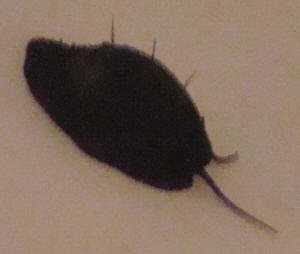 |
|
Hoof limpet - 11/07/09
Hello,
I have attached a picture of what I believe to be Hipponicidae
sp. residing on the back of one of my snails!
<Looks like it!>
I have 'Googled' around and found some supporting
information but wondered whether this was a true example of
symbiosis
<Mmm, of a sort... I'd label this animal as a "space
parasite"... as the "host" appears to be harmed to
a degree, and definitely doesn't seem to benefit from the
Limpet>
or just an accident. The forked proboscis (if that's the
right term) extends significantly from the shell during feeding
as it picks around the areas that the snail is grazing so I
assume is diet is basically the same.
I not been able to narrow down to species level but suspect that
it is a harmless hitchhiker as the 'host' seems to be
unaffected.
<Mmm... I don't know... having something so large, heavy
on ones shell...>
I found it interesting and have not seen any similar pictures on
the web so wondered whether you would be interested too.
<Yes. Thank you for sharing>
Forgive my ignorance if it is actually common and I'm just
bad at web searches but if it is unusual I can think of no better
place to share it.
Your site has helped me a great deal over the years and continues
to be my favourite reference as the reliability and accuracy of
information here is in my humble opinion, above question.
Many Thanks,
Chris
<Welcome Chris! Bob Fenner>
|
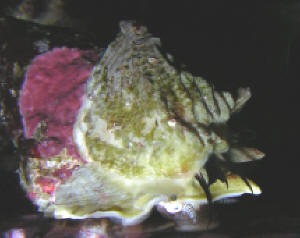 |
|
Unknown Gastropod Eating Starfish: Possible Snail
Predation and/or Dying Sand-Sifting Star -- 10/14/09
Crew,
<Hello Aaron, Lynn here this morning.>
This morning I woke up to find this guy with his stomach extruded
dissolving my sand sifting starfish.
<Interestingly enough, these snails don't actually extrude
their stomachs like we're used to seeing with sea stars.
Instead, they use a proboscis which is basically a mouth on the
end of a flexible trunk that's used to tear away/remove bits
of flesh. It's still not good though, to wake up seeing a
snail apparently dining on your sea star - no matter the
method!>
This guy was a tiny hitchhiker on a piece of live rock I
purchased three years ago and has grown to about 2.5"
long.
<Wow>
He has a long trunk similar to a conch, but much skinnier. He
only comes out at night.
<Looks/sounds whelk or whelk-like.>
He has co-existed with the starfish for about two years without
incident. As you can see, he completely consumed one of the
starfish's arms, and severed another.
<Yikes! I can't help but wonder if the star wasn't
doing well and the snail was simply scavenging on dying flesh --
or getting a head start on a star that was on the way out. These
stars are very difficult to keep and can take a surprisingly long
time to starve to death. What size system do you have?>
I threw him in my sump/refugium.
<Can't blame you there -- better safe than sorry!>
The starfish seems to still be alive. Do you think it will live?
Will its arms regenerate?
<Given otherwise good health, good water quality, lack of
predation, ample food and time, hopefully so.>
Can you identify the predacious gastropod?
<Possibly so, but I'd need several good/detailed photos
and the location of origin (where the live rock came from).
Photos should include at least one of the underneath portion of
the snail (where the opening is located), one of the opposite/top
side, and if possible, one showing the snail crawling around (in
water) so I can see the soft tissue (foot and any other anatomy
including the operculum/trapdoor).>
(FYI, the stringy thing on the gastropod's shell is a tube
worm, not the trunk)
<Thanks, any and all information you can give me is
helpful!>
Is there any benefit to keeping him?
<I'll be able to tell you more when I know exactly what it
is.>
Does he also eat detritus or algae,
<Ditto above>
..or has he just been grazing on copepods and worms that live
inside the live rock
<It's possible that he's survived so far by scavenging
leftover food remnants. If he indeed attacked a healthy sea star,
it's possible that he's not been able to find enough food
and is going after the most easily accessible source.
Supplemental feedings could help discourage this from happening
again, but I wouldn't bet on it.>
..by extruding his stomach and eating those also? Could he be the
reason I have had zero luck with anemones?
<Shouldn't be>
Will he eat corals?
<I doubt it but, again, I'll know more when I can
determine exactly what it is.>
Thanks! You guys are awesome.
<Sorry I couldn't give you a concrete ID! Do please send
along more photos if/when you get the chance. In the meantime,
I'd leave the little fellow in the sump and away from the
display. You might try tossing it a bit of fish, shrimp, etc.,
and watch its reaction. I'm betting this guy is a
predator/scavenger and will likely react pretty quickly to a bit
of food. I'd also keep an eye on that poor star. Watch for
holes in the center and signs of further disintegration. I
suspect the poor thing may have been on the way out and the snail
was simply acting on an opportunity to feed. Please see the WWM
FAQ's regarding these stars for more information. Start with
the following link (see related links at top of page as well):
http://www.wetwebmedia.com/sndsftstrdis.htm>
Aaron Chandler
<Take care, LynnZ>
|
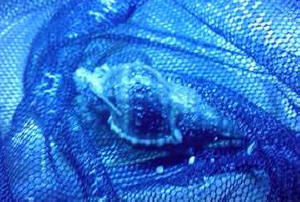 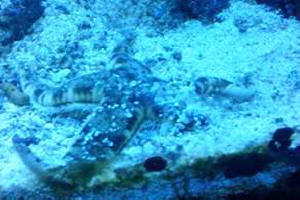 |
|
What Are These? Likely Nassarius Species -
10/9/09
Hi,
<Hi there, Lynn here this afternoon.>
Can you help me out?
<I'll sure try.>
Before I put these in my tank! lol
<Heee! I'll hurry!>
These were sent to me as Tongan Nassarius snails.
<Uh-oh. That's the trouble with common names. They're
not specific!>
They look like whelks or something not good.
<I can understand your thinking. I'd be concerned as well.
Nassarius snails and whelks can indeed resemble each other. Both
are in the same Superfamily, Buccinoidea. The good news is that,
as we know from experience, not all in this large group are a
danger to the other snails, etc., we keep in our tanks. The most
commonly kept Nassarius species are beneficial scavengers, living
the majority of their lives buried in the sand until feeding
time, when they erupt en masse. That's not to say that all
Nassarius are harmless, though. The larger species in particular
can pose a significant a threat if they're not supplied with
enough readily available food.>
These are NOT what the picture in their ad showed and NOTHING
like my AUTHENTIC Tongans. (see picture below this one to see
mine).These are mine and these are Tongan.....
<Yes, they're not what I'm used to seeing tagged as
Super Tongan snails either, but again, that's the problem
with common names. The snails you received most closely resemble
Nassarius margaritiferus, or Nassarius margaritifer depending on
the source. They're commonly called a 'Margarite
Nassa' snail. Now, the big question of the day is whether
these will be well-behaved and not eat their fellow snail
tankmates. Unfortunately, I honestly can't answer that with
any certainty. It could go either way. They're almost
certainly scavengers but whether they'll attack your other
snails is up in the air. You can either release them, keep them
fed and keep an eye out for trouble, or perhaps put them in
another tank, feed them as usual for a couple of days, then add a
snail and see what happens. If they go after the poor thing, get
it out of there before it's killed. For more
information/photos, please see the following links:
http://www.gastropods.com/3/Shell_3313.shtml
More photos so you can see the variation:
http://www.conchology.be/t=27&family=NASSARIIDAE&species=Nassarius%20margaritifer
Take care and good luck, LynnZ>
Part 2: What Are These? Likely Nassarius Species -
10/9/09
Hi,
<Hello, Lynn here again.>
Here are more of the "Nassarius" snails.
<Excellent photos!>
I tried to find something about how to tell the difference
between the Tongan and these "TONGAN" impostors. They
have a thing that looks like can seal themselves up in a
watertight type door (not the reddish brown "door" on
the right).
<Called an operculum>
My REAL Tongan Nassarius snails, I have NEVER seen inside their
shells. A LOT of their body is WAY out in the open.
<They can seal themselves inside.>
So are these whelks and should I flush them?
<No! Even if you do find that these snails won't work in
your tank, please try to find them another home (perhaps at a
LFS). Please see previous email and check photos for comparison.
Take care, LynnZ>
|
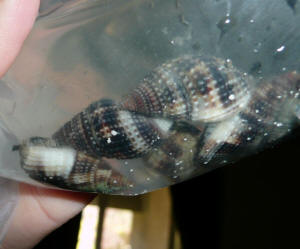 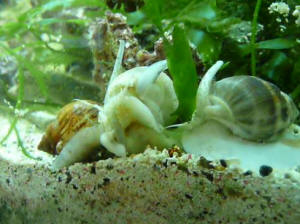
 |
Part 3: What Are These? Likely
Nassarius Species - 10/9/09
<Hello again>
I found this link below:
http://www.wildsingapore.com/wildfacts/mollusca/gastropoda/nassariidae/livescens.htm
<Yes, I believe the species shown (see photos in the bottom
group) is the same one I linked in the original message: Nassarius
margaritiferus, a common specie in the Philippines. The fact that
they refer to it, at that site, with the common name
'whelk' doesn't necessarily mean that it's a snail
killer. It may or may not be.>
Scroll down to the NOT REEF SAFE on this link.... we have a
winner!!!!..... http://www.chucksaddiction.com/Hitchsnails.html
<Ah yes, my friend in the Philippines -- great guy! I don't
see a photo of your snail at his link but the term 'not reef
safe' is used there to indicate the fact that Nassarius snails
(even those you already have) can and do eat the beneficial little
critters within sand-beds. In that respect, they are not reef-safe.
Are they safe with other snails? Maybe.>
Now here are the snails I have.... yeah, teeth like bumps on the
opening!!!!! In the Nassarius family yet, but not the "dog
whelks" that are safe like mine.
<Heeee! Don't get me started again on common names!
LynnZ>
Part 4: What Are These? Likely Nassarius Species -
10/9/09
Well, I think I have found my answer......
<Yay!>
Excerpt from Reefkeeping.com article by Ronald Shimek PhD
"These problems notwithstanding, it is generally pretty easy
to determine if a snail is a whelk. Whelk shells are generally
biconical or broadly fusiform. Their aperture is typically oval.
The animals typically, but not always, have an operculum on the
back of their foot which plugs the aperture when the animal
withdraws into its shell. If such an operculum is present, it is
made of protein and typically is brown, golden or black; and it is
never calcareous and round, but rather oval, crescent-shaped or
somewhat "leaf-shaped."
Whelks always have a siphonal canal with an anterior siphonal
notch.
The notch is generally quite distinctive, although the canal may be
short and twisted. All other sculpturing is variable and dependent
upon at least species, and maybe upon environment."
http://www.reefkeeping.com/issues/2005-11/rs/index.php
<Thank you, that's very informative! LynnZ>
Part 5: What Are These? Likely Nassarius Species -
10/9/09
<Hi>
"FLUSH" is a relative term!
<Whew, that's good! You had me going there for a
sec!>
lol Here in Las Vegas they would not survive,
<Not in freshwater, that's for sure!>
..but I do NOT want to give them to someone and have them harm
their charges.
<No, you would never want to give them to anyone without full
disclosure. You could, however, offer them to a LFS. I'd
explain the situation and see what they say. They might be able to
take them off your hands, or even offer you some sort of
credit/exchange.>
The REAL SUPER Tongan.... NEVER, I mean NEVER have I see them close
up in their shell.
<I understand. You may have never seen them close up all the
way, but they can. All of these snails have an operculum and can
seal themselves within their shell. Sometimes that operculum can be
hard to see, though! In your Super Tongan photo, if you take a look
at the individual on the right, you'll see a small light brown
operculum towards the end of the foot. If push came to shove, the
snail would pull in on itself and close up shop. Snails use their
operculum mainly as a defense against predation and
desiccation/drying out. In the normal course of grazing/traveling
about without threat, there's no need for them to close up. The
only time I've ever seen any of my snails close up is if
they're in trouble (ailing or dead) or feeling
threatened.>
If they tried, it took a while, but they try to flop over and
slither first. The whelks pull in QUICKLY like these.
<'¦>
Yeah operculum... I was being "general" for layman
reasons.
<That's perfectly understandable. I just wanted you to have
the term in case you wanted to look it up. Snails are fascinating
creatures. Some have a thin/flexible operculum like what we see in
this group of snails, while others have a thickened, calcareous
version. Conchs actually have a claw-like operculum that they use
to aid in locomotion. It's not exactly graceful, but it
works!>
Nonetheless, I will not be adding them to my tank......
<Can't say I blame you!>
SIDE question... Can Halichoeres (Clown wrasse) wrasses decimate a
copepod/amphipod population in a tank? I have always had fairy
wrasses
<Love fairy wrasses!>
..and though they would eat them here and there, there would always
be plenty on the rocks.
<I think the wrasse would nab what it could, but there would
always be nooks and crannies for the 'pods to hide. Be sure to
check out Bob's page on his pick for the three best candidates:
http://www.wetwebmedia.com/halichoeresbestart.htm >
Thanks
<You're very welcome. --LynnZ>
Part 6: What Are These? Likely Nassarius Species -
10/9/09
Hi,
<Hello>
Sorry I have to disagree about the ones I have eating stuff in the
sand.
<No problem. I'm not always right and individuals can
differ.>
They go under and stay in the SAME SPOT until I put in some fish
flesh.
<Sounds like they're trained! It also sounds like
they're very well fed, which is terrific.>
THAT being said, there ARE species of Nassarius that are not good
for the sand bed. Plus if they were, my water quality would be
shaky, so no, these I have... my true TONGAN or NASSARIUS DISTORTUS
are perfectly suited.
<I'm glad to hear that.>
I had a Sand Sifting Star fish that ATE everything in my sand
bed,
<It happens, yes.>
..causing serious water quality issues.... that was when I FIRST
had a tank years and years ago and the dope at the LFS said I
should get that Sea star!
<Not good>
He knew my tank was only 55 gallons. So my experience with a dead
sand bed in the past would indicate that My N. distortus are
fine.
<Good to hear.>
Oddly Nassarius are part of the whelk family, but not destructive
in attacking other snails.
<That's right for the most part. I've heard the
occasional report of a Super Tongan snail attacking others but
I've never had any problems with mine. Perhaps the snails were
starving or perhaps the person had another snail entirely that they
called a "Super Tongan".>
I have never seen mine go near any other creature in the tank....
in fact they get bumped by something and they go under the
sand!
<Heee! It sounds like you've got some good snails! Take
care, LynnZ>
Part 7: What Are These? Likely Nassarius Species -
10/9/09
<Hello>
Okay, is that other thing that is pink, the think they use to kill
other snails etc, with?
<If the animal is indeed a snail killer then, yes, it would use
its proboscis/mouth (the pink thing) to kill/rip tissue from its
prey. It's also used by non-snail killers as well, like
Nassarius vibex. The proboscis is basically a flexible trunk with a
mouth on the end. The dark thing you see sticking up is the siphon.
It's used for breathing as well as for scenting prey/food. You
can't see it in the photo, but at the base of the each
'cephalic' tentacle, you should be able to see an eye.
Here's a good link regarding whelk/snail anatomy that you might
find interesting: http://webs.lander.edu/rsfox/invertebrates/busycon.html
>
It was about 1" LONG before I took the picture.
<The snail's probably hungry and testing the
Styrofoam!>
What are your thoughts on that?
<I think it's a great photo - thanks! Take care,
LynnZ> |
|
|

